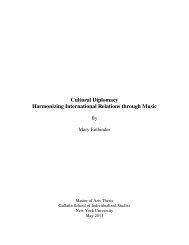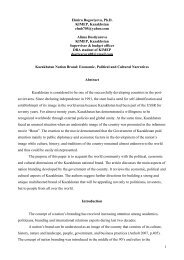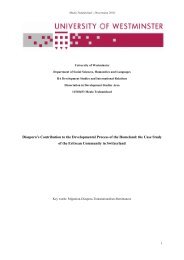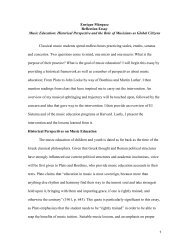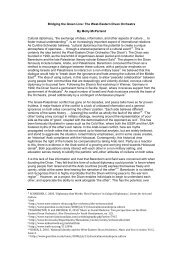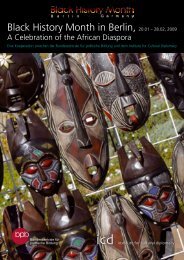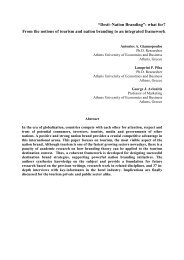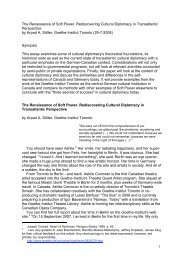Hable con ella - Institute for Cultural Diplomacy
Hable con ella - Institute for Cultural Diplomacy
Hable con ella - Institute for Cultural Diplomacy
Create successful ePaper yourself
Turn your PDF publications into a flip-book with our unique Google optimized e-Paper software.
Pina Bausch in Pedro Almodóvar’s <strong>Hable</strong> <strong>con</strong> <strong>ella</strong> 437<br />
per<strong>for</strong>mances. Benigno advises Marco to talk to Lydia as well, hence the title of the film.<br />
Originally, Almodóvar wanted to call his film “The Man Who Cried,” but Sally Potter<br />
had already taken this very title <strong>for</strong> her 2000 film starring John Turturro and Christina<br />
Ricci (Scott 163).<br />
Almodóvar points out that film is about “the joy of narration” and about “narrators”<br />
– “men who talk to whoever can hear them and above all to those who can’t” (Talk to<br />
Her. Press Book 7). Of no lesser importance in light of the metanarrative plane of the<br />
play is the thematization of the process of the <strong>con</strong>scious looking at, or more precisely, of<br />
the <strong>con</strong>scious viewing, of “per<strong>for</strong>mance.” Observing and watching occurs at different<br />
levels – one, at the level of narrative in the film and, two, at the level of its reception.<br />
In the narrative, it is routinely through a scenario of watching that the protagonists are<br />
brought together. As discussed above, the film starts out with the per<strong>for</strong>mance clip of<br />
Café Müller (with the first encounter between Benigno and Marco) and ends with the<br />
per<strong>for</strong>mance of Masurca Fogo in the same theatre (with the first encounter between<br />
Marco, Alicia, and her dance teacher). There are many more scenarios that underscore<br />
the importance of the act of watching: Marco sees Lydia the first time in a television<br />
talk-show, Benigno observes Alicia during her dance lessons from his apartment. At a<br />
garden party, Marco and Lydia watch the per<strong>for</strong>mance of a romantic song (“Cucurrucucú<br />
Paloma,” in a rendition by the Brazilian vocalist Caetano Veloso), and on the crucial day<br />
of Lydia’s final bullfight they watch a wedding ceremony together. Later Marco watches<br />
Lydia in the bullfight. In the hospital, he reencounters Benigno, watching him per<strong>for</strong>m<br />
his body-hygienic routine on Alicia, and it is the sight of Alicia’s naked breast that<br />
arouses his curiosity. After Benigno’s death he moves into his apartment and discovers<br />
the view into the dance studio, thus repeating Benigno’s voyeuristic observing as he recognizes<br />
Alicia exercising.<br />
As spectators of the film, we are of course watching throughout, but we are<br />
particularly drawn into the picture during point-of-view shots, when the camera<br />
perspective is identical with the perspective of the subject, and during close ups<br />
and camera angles that make us feel as if we were present at the same location.<br />
This is the case in the first hospital scene, where Benigno and another nurse wash<br />
and groom Alicia. Her body appears as if on display <strong>for</strong> the camera (Jones 15).<br />
Cinematographic care is taken in the shooting of the dressing scene of Lydia prior to<br />
the bullfight, with close-ups and tracking shots that follow every move of Lydia as<br />
she puts on and buttons up the brocade bolero-jacket and adjusts the fit of her tights<br />
of the bullfighting costume. The resulting effect of the camera work, in combination<br />
with warm glowing colours, is a very sensual one, as if the camera were caressing<br />
the body.<br />
Julian Smith has pointed out the sexual ambiguity of the character Lydia, played<br />
by the singer Rosario Flores, as a female bullfighter, which seems to resonate with<br />
the frequent cross-dressings in Bausch’s theatre (25). Most important as a showpiece<br />
of per<strong>for</strong>mance within the film, however, is the subsequent bullfight scene,<br />
which employs cinematographic techniques that Bausch has adopted from cinema<br />
– repetition and slow motion, the focus on one particular gesture of the torero (the<br />
turn as the bull passes, with erect posture, upper body extended back, and rotated,



